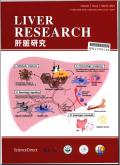Combination of brefeldin A and tunicamycin induces apoptosis in HepG2 cells through the endoplasmic reticulum stress-activated PERK-eIF2α-ATF4-CHOP signaling pathway
IF 2.1
Q2 Medicine
引用次数: 0
Abstract
Background and aims
Hepatocellular carcinoma (HCC) is a malignant tumor with a high mortality rate, but there are still no effective treatments. The aim of this study was to investigate the anticancer potential of the combined use of brefeldin A (BFA) and tunicamycin (TM) in HepG2 cells, as well as the underlying mechanisms.
Methods
HepG2 cells were treated with different concentrations of BFA (0.1–2.5 mg/L) and TM (1–5 mg/L) for 24 h. DMSO (0.1 %, v/v) was used as a vehicle control. Cell viability and cell migration were measured using MTT assay and scratch wound assay, respectively. Apoptosis was detected using flow cytometry and acridine orange (AO) staining. The protein and mRNA levels of various factors involved in apoptosis (poly (ADP-ribose) polymerase-1 (PARP-1), caspase-12, caspase-3, and stearoyl-CoA desaturase 1) and endoplasmic reticulum (ER) stress (binding immunoglobulin protein (BiP), protein kinase R-like endoplasmic reticulum kinase (PERK), p-PERK, phosphorylation of eukaryotic translation initiation factor 2alpha (p-eIF2α), activating transcription factor (ATF) 4, and C/EBP homologous protein (CHOP)) were measured using Western blotting and qRT-PCR, respectively.
Results
Both BFA and TM alone significantly reduced the viability of HepG2 cells in a dose-dependent way. The co-incubation with TM (1 mg/L) further significantly reduced the viability of HepG2 cells treated with BFA (0.25 mg/L) alone (P < 0.05). BFA significantly increased the protein and mRNA levels of caspase-3 and PARP-1 (P < 0.05) compared to control and DMSO-treated cells, indicating that BFA induced apoptosis in HepG2 cells by increasing the expression of caspase-3 and PARP-1. The induction of apoptosis by BFA could be further significantly enhanced by co-incubation with TM. In addition, BFA significantly increased the mRNA levels of BiP, PERK and ATF4 (P < 0.05) compared to control and DMSO-treated cells. After co-incubation of BFA and TM, the protein levels of BiP, p-PERK, p-eIF2α and CHOP were significantly increased, indicating that TM could enhance BFA-induced ER stress in HepG2 cells through the PERK-eIF2α-ATF4-CHOP pathway.
Conclusions
BFA could induce apoptosis and ER stress, and TM could enhance the ability of BFA to induce apoptosis and ER stress in HepG2 cells through the PERK-eIF2ɑ-ATF4-CHOP pathway. The findings highlight the therapeutic potential of the combined use of BFA and TM in treating HCC.
brefeldin A联合tunicamycin通过内质网应激激活的PERK-eIF2α-ATF4-CHOP信号通路诱导HepG2细胞凋亡
背景与目的肝细胞癌(HCC)是一种死亡率高的恶性肿瘤,目前尚无有效的治疗方法。本研究的目的是探讨brefeldin A (BFA)和tunicamycin (TM)联合使用在HepG2细胞中的抗癌潜力及其潜在机制。方法用不同浓度的BFA (0.1 ~ 2.5 mg/L)和TM (1 ~ 5 mg/L)处理shepg2细胞24 h,以DMSO (0.1%, v/v)作为对照。分别采用MTT法和抓伤法测定细胞活力和细胞迁移量。流式细胞术和吖啶橙(AO)染色检测细胞凋亡。参与细胞凋亡的各种因子(聚(adp -核糖)聚合酶1 (PARP-1)、caspase-12、caspase-3和硬脂酰辅酶a去饱和酶1)和内质网(ER)应激(结合免疫球蛋白蛋白(BiP)、蛋白激酶r样内质网激酶(PERK)、p-PERK、真核翻译起始因子2α (p-eIF2α)磷酸化、激活转录因子(ATF) 4、分别采用Western blotting和qRT-PCR检测C/EBP同源蛋白(CHOP)。结果BFA和TM均能显著降低HepG2细胞活力,且呈剂量依赖性。与TM (1 mg/L)共孵育进一步显著降低BFA (0.25 mg/L)单独处理HepG2细胞的活力(P <;0.05)。BFA显著提高了caspase-3和PARP-1的蛋白和mRNA水平(P <;0.05),表明BFA通过增加caspase-3和PARP-1的表达诱导HepG2细胞凋亡。BFA与TM共孵育可进一步显著增强BFA对细胞凋亡的诱导作用。此外,BFA显著提高了BiP、PERK和ATF4 mRNA水平(P <;0.05),与对照组和dmso处理的细胞相比。BFA与TM共孵生后,BiP、p-PERK、p-eIF2α和CHOP蛋白水平均显著升高,说明TM可通过PERK-eIF2α-ATF4-CHOP通路增强BFA诱导的HepG2细胞内质网应激。结论sbfa可诱导HepG2细胞凋亡和内质网应激,而TM可通过PERK-eIF2 -ATF4-CHOP通路增强BFA诱导HepG2细胞凋亡和内质网应激的能力。研究结果强调了联合使用BFA和TM治疗HCC的治疗潜力。
本文章由计算机程序翻译,如有差异,请以英文原文为准。
求助全文
约1分钟内获得全文
求助全文

 求助内容:
求助内容: 应助结果提醒方式:
应助结果提醒方式:


